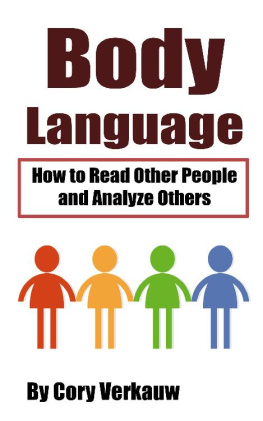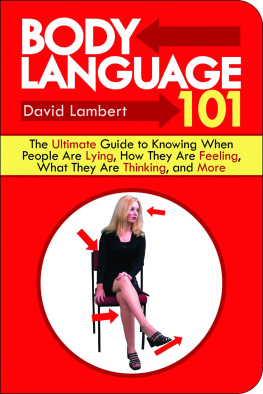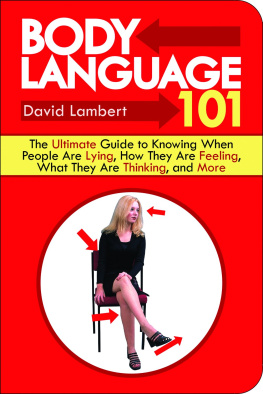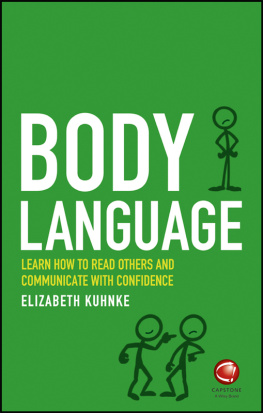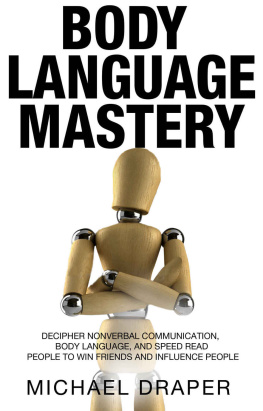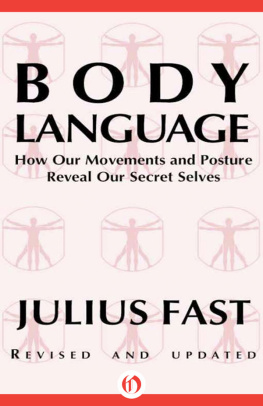Wright - Body Language 101: Expert Advice on How to Detect Body Language Signs of Lying (Body Language, Body Language for Dummies, Body Language Book)
Here you can read online Wright - Body Language 101: Expert Advice on How to Detect Body Language Signs of Lying (Body Language, Body Language for Dummies, Body Language Book) full text of the book (entire story) in english for free. Download pdf and epub, get meaning, cover and reviews about this ebook. year: 2016, genre: Home and family. Description of the work, (preface) as well as reviews are available. Best literature library LitArk.com created for fans of good reading and offers a wide selection of genres:
Romance novel
Science fiction
Adventure
Detective
Science
History
Home and family
Prose
Art
Politics
Computer
Non-fiction
Religion
Business
Children
Humor
Choose a favorite category and find really read worthwhile books. Enjoy immersion in the world of imagination, feel the emotions of the characters or learn something new for yourself, make an fascinating discovery.

- Book:Body Language 101: Expert Advice on How to Detect Body Language Signs of Lying (Body Language, Body Language for Dummies, Body Language Book)
- Author:
- Genre:
- Year:2016
- Rating:5 / 5
- Favourites:Add to favourites
- Your mark:
- 100
- 1
- 2
- 3
- 4
- 5
Body Language 101: Expert Advice on How to Detect Body Language Signs of Lying (Body Language, Body Language for Dummies, Body Language Book): summary, description and annotation
We offer to read an annotation, description, summary or preface (depends on what the author of the book "Body Language 101: Expert Advice on How to Detect Body Language Signs of Lying (Body Language, Body Language for Dummies, Body Language Book)" wrote himself). If you haven't found the necessary information about the book — write in the comments, we will try to find it.
Body Language 101: Expert Advice on How to Detect Body Language Signs of Lying (Body Language, Body Language for Dummies, Body Language Book) — read online for free the complete book (whole text) full work
Below is the text of the book, divided by pages. System saving the place of the last page read, allows you to conveniently read the book "Body Language 101: Expert Advice on How to Detect Body Language Signs of Lying (Body Language, Body Language for Dummies, Body Language Book)" online for free, without having to search again every time where you left off. Put a bookmark, and you can go to the page where you finished reading at any time.
Font size:
Interval:
Bookmark:
Body Language 101
Expert Advice on How to Detect Body Language Signs of Lying
Table of Contents
Copyright Notice
Copyright 2015 by Dona Wright - All rights reserved.
This document is geared towards providing exact and reliable information in regards to the topic and issue covered. The publication is sold with the idea that the publisher is not required to render accounting, officially permitted, or otherwise, qualified services. If advice is necessary, legal or professional, a practiced individual in the profession should be ordered.
- From a Declaration of Principles which was accepted and approved equally by a Committee of the American Bar Association and a Committee of Publishers and Associations.
In no way is it legal to reproduce, duplicate, or transmit any part of this document in either electronic means or in printed format. Recording of this publication is strictly prohibited and any storage of this document is not allowed unless with written permission from the publisher. All rights reserved.
The information provided herein is stated to be truthful and consistent, in that any liability, in terms of inattention or otherwise, by any usage or abuse of any policies, processes, or directions contained within is the solitary and utter responsibility of the recipient reader. Under no circumstances will any legal responsibility or blame be held against the publisher for any reparation, damages, or monetary loss due to the information herein, either directly or indirectly.
Respective authors own all copyrights not held by the publisher.
The information herein is offered for informational purposes solely, and is universal as so. The presentation of the information is without contract or any type of guarantee assurance.
The trademarks that are used are without any consent, and the publication of the trademark is without permission or backing by the trademark owner. All trademarks and brands within this book are for clarifying purposes only and are the owned by the owners themselves, not affiliated with this document.
Disclaimer
While all attempts have been made to verify the information provided in this book, the author does not assume any responsibility for errors, omissions, or contrary interpretations of the subject matter contained within. The information provided in this book is for educational and entertainment purposes only. The reader is responsible for his or her own actions and the author does not accept any responsibilities for any liabilities or damages, real or perceived, resulting from the use of this information.
What does communication mean to you?
Most people never consider such a question. Communication is words and ideas and how we share them, right? We talk to one another when we pass on the street, we call each other on the telephone, we text our friends, send emails to our cousins, and write letters home to mom and dad. While the technology has changed dramatically in the last quarter century, most people would say that we still communicate primarily with our words.
What if you were to one day find out about a learnable and teachable technique that will allow you to know more about most people from simply watching them than any amount of conversation could possibly teach you?
Sounds crazy, right?
The really crazy part, though, it exists, and it's not just some crazy hocus pocus! It's science! In fact, people have probably applied this very science to you sometime recently. Remember the last big job interview that you aced? The interviewer knew you were right for the position before you ever even sat down. Ever marveled at how the police are able to get confessions out of even the most hardened criminals?
Have you wondered how that great server at your favorite diner knows exactly when you need your coffee topped off? All of those people are practicing the same science that we're talking about. What do they all have in common? Just like you, they're not scientists!
It's all about learning the science of body language. We usually don't even consider what our bodies are doing when we are saying words, but hidden in the way we sit, the way we shake hands, and the way we look at the people we're talking to are secrets about what we're really feeling on the inside.
Have you ever heard the old saying, "Your smile betrays your true feelings?" Not only is that true, but so does the direction your toes point while sitting and talking, where you place your hands when sitting across a desk from somebody, or even how you gesture with your hands!
Imagine being able to learn all of those tell-tale signs and having the ability to know what the person that you're talking to truly means. Wouldn't that be empowering? Think about how confident you'd become, knowing that the new person you're dating was lying about where they were last night when they missed dinner. I bet you can think of a situation right now where simply knowing in advance that a business partner, spouse, coworker, friend, or relative wasn't telling the truth could've saved you a boatload of hassle.
Imagine the freedom that will come with learning this new skill, making it second nature, and being able to use it literally every single time you speak with another person for the rest of your life .
That's some powerful stuff, right?
All of that and more is possible if you simply read and absorb the information and advice in this book. Within these pages, you will learn exactly how to tell when somebody is acting nervously, without confidence, or dishonestly, simply by interpreting their body movements and facial expressions. If you're ready to empower yourself with that kind of tool, then read on!
BONUS: Your FREE Gift

Thank you for purchasing my book: " Body Language ". I want to show you my appreciation by offering an exclusive eBook 10 Secrets That Will Help You Improve Your Photographic Memory for FREE.
Simply Click the Button Below

OR Go to This Page
http://successmasterycamp.com/free/
The scientific study of body language is formally known as kinesics. Simply put, it involves the study and interpretation of nonverbal communication via movements of the body. For our purposes, we'll keep it as simple as possible. It's a fancy scientific word for body language.
How do we know so much about it, though? Who came up with such an idea, and who studied it? When did we really start conceptualizing such a novel idea? Like most things, we can't begin to apply the science of body language until we understand a little bit about its background.
Let's hop into our imaginary time machine and take a trip to 1952. Famed American anthropologist Ray Birdwhistell was the first to study if, how, and why we communicate with our bodies. This wasn't some crackpot, either. Birdwhistell was a highly respected in his field, sporting a PhD from the prestigious University of Chicago. He worked alongside such luminaries as Margaret Meade and William Lloyd Warner. When Birdwhistell had an idea about human behavior, people listened.
Birdwhistell's work began in earnest, starting with a name being given to a theory, but quickly this study grew into a decades-long examination of the topic. His findings were ultimately published in the seminal book "Kinesics and Context."
This work led to many striking conclusions that resulted in a major shift in the way that we think about interpersonal communication. In his estimation, Birdwhistell guessed that less than forty percent of the meaningful content of a conversation between two people was included in the words. The other sixty percent, he postulated, was transmitted nonverbally through means such as body language. If Ray Birdwhistell is to be believed, it appears as though there is much more to the meaning of our body language than most people even today could ever imagine. Even if we conservatively estimate Birdwhistell's guess is only half-accurate, that still means that 30 percent of the communicating we do is through body language. That's an enormous amount of talking that we do without ever opening our mouths!
Font size:
Interval:
Bookmark:
Similar books «Body Language 101: Expert Advice on How to Detect Body Language Signs of Lying (Body Language, Body Language for Dummies, Body Language Book)»
Look at similar books to Body Language 101: Expert Advice on How to Detect Body Language Signs of Lying (Body Language, Body Language for Dummies, Body Language Book). We have selected literature similar in name and meaning in the hope of providing readers with more options to find new, interesting, not yet read works.
Discussion, reviews of the book Body Language 101: Expert Advice on How to Detect Body Language Signs of Lying (Body Language, Body Language for Dummies, Body Language Book) and just readers' own opinions. Leave your comments, write what you think about the work, its meaning or the main characters. Specify what exactly you liked and what you didn't like, and why you think so.







